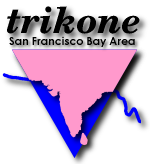Trikone

Trikone (Hindustani pronunciation: [t̪rɪˈkoːn]) is a non-profit support, social, and political organization for South Asian bisexual, lesbian, gay, and transgender people.[1][2][3] It was founded in 1986 in the San Francisco Bay Area and is one of the oldest group of its kind in the world.[4][5][6] South Asians affiliated with Trikone are from or trace their ancestry to the following countries: Afghanistan, Bangladesh, Bhutan, India, Maldives, Burma, Nepal, Pakistan, Sri Lanka, and Tibet.[7] Trikone publishes an eponymous magazine with an international base of subscribers several times a year.[8] The magazine is the oldest south Asian LGBT magazine in the U.S. which is completed 27 years in the mainstream media.[9]
Several metropolitan areas in North America aside from the San Francisco Bay Area also have organizations named "Trikone" (such as Trikone Northwest and Trikone Michigan), which have similar missions.[10]
Contents
1 History and activities
2 About the name
3 Women of Trikone
4 See also
5 References
6 External links
History and activities
The organization was co-founded in 1986 by Arvind Kumar and Suvir Das[11] with the name "Trikon" and the first newsletter was published with that name in January 1986. (The name was later changed to "Trikone" due to a name conflict with an unrelated organization, "Tricon.") Following media coverage in both the United States and India, a group soon formed to continue the publication of the newsletter and to participate in local events such as the San Francisco Gay & Lesbian Pride Parade.[12][13]
In 2000 and 2006: DesiQ, a South Asian queer conference of international scope was produced by the organization.[14] In September 2001 QFilmistan, a film festival, was also produced.[15]
About the name
"Trikone" (Hindi/Marathi/Sanskrit: त्रिकोण, Telugu: త్రికోణ్, Urdu: تْرِكون, Gujarati: ત્રિકોણ, Punjabi: ਤ੍ਰਿਕੋਣ, Bengali: ত্রিকোণ, Malayalam: ത്രികോൺ) means "triangle"[16] in many South Asian languages. The pink triangle is a historical symbol employed in gay liberation movements.
Women of Trikone
Women of Trikone is a sub group and also has separate a list-serve for queer women of South Asian descent from the Bay Area.[17]
See also
- List of LGBT organizations
References
^ Atkins, Dawn, ed. Looking queer: Body image and identity in lesbian, bisexual, gay and transgender communities. Psychology Press, 1998.
^ Leong, Russell, ed. Asian American sexualities: Dimensions of the gay and lesbian experience. Psychology Press, 1996.
^ Shah, Nayan. "9. Sexuality, Identity, and the Uses of History." Q and A: Queer in Asian America (1998): 141.
^ Vanita, Ruth. "Lesbian Studies and Activism in India." Journal of Lesbian Studies 11.3-4 (2007): 244-253.
^ "About Trikone". Retrieved 2008-02-02..mw-parser-output cite.citation{font-style:inherit}.mw-parser-output .citation q{quotes:"""""""'""'"}.mw-parser-output .citation .cs1-lock-free a{background:url("//upload.wikimedia.org/wikipedia/commons/thumb/6/65/Lock-green.svg/9px-Lock-green.svg.png")no-repeat;background-position:right .1em center}.mw-parser-output .citation .cs1-lock-limited a,.mw-parser-output .citation .cs1-lock-registration a{background:url("//upload.wikimedia.org/wikipedia/commons/thumb/d/d6/Lock-gray-alt-2.svg/9px-Lock-gray-alt-2.svg.png")no-repeat;background-position:right .1em center}.mw-parser-output .citation .cs1-lock-subscription a{background:url("//upload.wikimedia.org/wikipedia/commons/thumb/a/aa/Lock-red-alt-2.svg/9px-Lock-red-alt-2.svg.png")no-repeat;background-position:right .1em center}.mw-parser-output .cs1-subscription,.mw-parser-output .cs1-registration{color:#555}.mw-parser-output .cs1-subscription span,.mw-parser-output .cs1-registration span{border-bottom:1px dotted;cursor:help}.mw-parser-output .cs1-ws-icon a{background:url("//upload.wikimedia.org/wikipedia/commons/thumb/4/4c/Wikisource-logo.svg/12px-Wikisource-logo.svg.png")no-repeat;background-position:right .1em center}.mw-parser-output code.cs1-code{color:inherit;background:inherit;border:inherit;padding:inherit}.mw-parser-output .cs1-hidden-error{display:none;font-size:100%}.mw-parser-output .cs1-visible-error{font-size:100%}.mw-parser-output .cs1-maint{display:none;color:#33aa33;margin-left:0.3em}.mw-parser-output .cs1-subscription,.mw-parser-output .cs1-registration,.mw-parser-output .cs1-format{font-size:95%}.mw-parser-output .cs1-kern-left,.mw-parser-output .cs1-kern-wl-left{padding-left:0.2em}.mw-parser-output .cs1-kern-right,.mw-parser-output .cs1-kern-wl-right{padding-right:0.2em}
^ Ramakrishnan, L. "Putting the'B'Back in LGBT: Bisexuality, Queer Politics and HIV/AIDS Discourse." (2006).
^ Balachandran, Chandra S. "A preliminary report on emerging gay geographies in Bangalore." South Asia: Journal of South Asian Studies 24.s1 (2001): 103-118.
^ "Trikone magazines". Retrieved 2008-02-02.
^ Parasar, Anuradha. "Homosexuality In India–The Invisible Conflict."
^ Jeung, Russell. "RELIGIOUS IDENTITY AND MARGINALIZATION." Encyclopedia of Asian American Issues Today 1 (2010): 457.
^ Amlani, Alzak (2011-07-07). "Being Indian in America". India Currents. Retrieved 2017-08-10.
^ "Minority Gays Create a Voice for Unserved Community". Retrieved 2008-02-04.
^
Kumar, Arvind (2008-02-11). (Interview). Interviewed by Arvind Kumar. Missing or empty|title=(help)
^ "LGBT Pride Celebrations". Retrieved 2008-02-02.
^ "QFilmistan: The first South Asia LGBT film festival". Retrieved 2008-02-02.
^ Platts, John (1884). A dictionary of Urdu, classical Hindi, and English. London: W. H. Allen & Co. p. 319. ISBN 81-215-0098-2.
^ Women-of-Trikone Archived 2008-03-26 at Archive.today
External links
- DesiQ
- Trikone Bay area email lists
- Trikone Announcement List
- Women of Trikone Group
